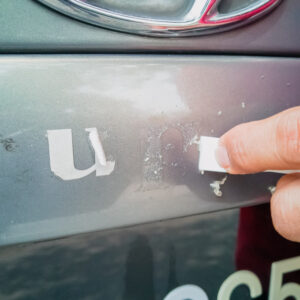You need to protect your car’s paint from harmful substances, such as tree sap and bird droppings. These could ruin its natural shine and beauty. Not to mention investing in extra protection can extend the lifespan of your daily driver’s exterior.
There are different ways to do it, but one of the most effective is applying chemical mixtures designed to coat the paint job. This gives the exterior a protective shield against the elements.
Best Car Paint Protection Options
There are two types of car paint protection, namely: ceramic and film.
Ceramic ones are liquid products that are sprayed, acting as an additional layer over the car paint. On the other hand, the film is made from urethane and is manually attached to the vehicle’s exterior.

With that said, here are some of the best car paint protection available:
Detailing Spray
Detail spraying uses detail sprays made from polymers and lubricants. It’s designed to remove dirt and debris from a car’s surface without damaging the paint.
Besides cleaning the exterior, detail sprays also leave behind a glossy finish. You can also use it on other parts, such as the windows or glasses, wheels, and the interior. The versatility and effectiveness of these sprays make it one of the more popular choices to protect car paint.
However, detail sprays also come with disadvantages. You can’t use them as a substitute for proper car washes. It can cause scratches and swirl marks if you do because it won’t properly remove the dirt.
As far as price goes, full-service detailing ranges from $150 to $500, depending on different factors, such as vehicle size and the services included.
Paint Sealant
Paint sealants are made of polymers that prevent dirt from damaging the paint. They’re similar to car waxes, protecting the exterior from harsh elements, like UV rays from sunlight. The main difference is sealants tend to last longer.
Another advantage they have over other car paint protection is sealants are relatively simple to apply. Simply spray them on the car’s exterior, and you’re set.
With that said, sealants have harmful chemicals that could damage your skin. So, while they’re easy to use, it’s recommended to have a professional do it for you.
The price of applying paint sealant on your vehicle depends on a handful of things, such as vehicle size, but expect it to be somewhere between $100 and $200.
Paint Protection Films
As mentioned, paint protection films (PPF) are made from urethane. They’re attached to areas on the car that need protection against scratches, bug guts, and other minor abrasions.
One advantage PPF has over others is its self-healing nature. It makes films effective against small scratches and minor impurities as they can easily handle them. Some other advantages include:
- Produces an enhanced finish
- Protection against corrosion
- Resistant to extreme temperatures
- Easy to repair
- Long-lasting protection
- Nearly invisible

Although it’s effective, there are some cons to using PPF. A glaring one is it doesn’t provide a glossy finish compared to other options. Additionally, applying PPF on your vehicle can be time-consuming, as opposed to spraying liquid protection.
And if you decide on hiring a professional, expect the price to range from $600 to over $4,000. The cost depends on the parts you want to cover. And if you want the entire vehicle protected, it would cost an average of $5,000 for a standard SUV or sedan.
Other Ways to Protect Car Paint
Besides using ceramic and film, you can protect your car’s paint by using wax, wraps, and car covers.
Wax
Wax adds a temporary protective layer against environmental elements. Wax isn’t as durable as ceramic protectants because of the chemical bonds ceramic creates.
However, wax does have advantages like being resistant to scratches, keeping the car clean, and maintaining luster.
Wraps
Car wraps are special vinyl films applied to car panels, like the hood, doors, fenders, roof, decklist, bumpers, and more.
They protect the paint, similar to wax and ceramic. Besides that, wraps are cheaper, faster to apply, and easy to maintain, among others.
Car Covers
Car covers (made from polypropylene, stain, or solution-dyed acrylic) are fabric sheets you use to cover up the entire vehicle. They protect the exterior from the elements, harmful UV rays, animal droppings, dirt, grime, and debris.
While they don’t offer the same protection as ceramic or film, covers have their advantages. Some notable ones include ease of use, longevity, and cost-efficiency. After all, you only need one cover, as long as you take care of it.
Benefits of Car Paint Protection
Besides protecting the car paint, extra protection also retains the vehicle’s value and prolongs the paint’s lifespan.
Protects the Paint Job
Car paint protection adds an additional layer over the exterior of the paint, which acts as a shield against the elements. This protects the paint job because scratches and chips are inflicted on the added layer instead.
Retains the Vehicle’s Value
Different factors determine a vehicle’s value, such as age, mileage, features, and condition. And since film and ceramic protect the paint job, it essentially maintains your car’s value. This is important because it makes it easier to resell your vehicle in the events you want to.
Prolongs the Paint’s Lifespan
As mentioned, film and ceramic acts as an added protection to the car’s exterior. This extends the lifespan of the paint job. Besides the aforementioned retention in value, a healthy paint job also saves you money in the long run, as you won’t have to frequently repaint your car.
In California, repaints range from a few hundred dollars up to north of a thousand.
Any information provided on this Website is for informational purposes only and is not intended to replace consultation with a professional mechanic. The accuracy and timeliness of the information may change from the time of publication.




















